
Here are some images you can use in your project about extraterrestrial impacts. These latest images were taken in April 2007 at Meteor (Barringer) Crater, Arizona
Meteor (Barringer) Crater is one of the best-preserved examples of impacts from outer space…
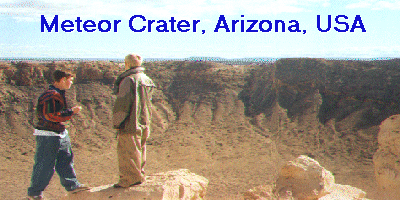
Located 35 miles East of Flagstaff, and a 5-mile drive off Interstate highway I-40, the Barringer Meteorite Crater, as it is known in the scientific community, is one of the best-preserved craters on Earth since its formation approximately 50000 years ago.
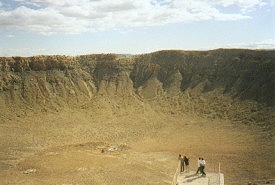
The crater is 1.2 kilometres in diameter, and 200 metres deep. What conditions were needed for a crater of this size to be formed? Calculations have shown that the meteorite would need to be 50 metres in diameter and travelling at a velocity of 11 kilometres per second. There are two factors which are important in the energy of movement, known as kinetic energy: the mass of the body, and its velocity. A diameter of 50 metres might not seem that big, but its high velocity was a significant factor in the destructive power (the energy is proportional to the square of its velocity !)
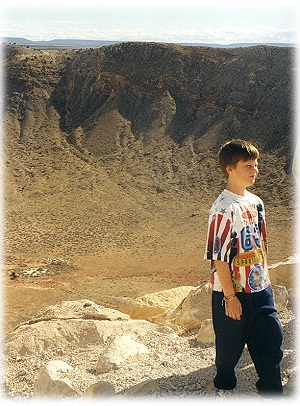
Under such an impact the iron-nickel meteorite, most of it would have melted, disintegrated, and it would have been partially vaporised. Similar conditions arose for the rocks and iron on the ground, as a result of the enormous pressures and high temperatures, from the energy of impact. What an excellent example of the conversion of kinetic energy into heat energy! Yet some of the kinetic energy was used in complete fragmentation of rocks beyond the melted region, and in the energy needed to eject these rock at high velocities from the ground into the air.
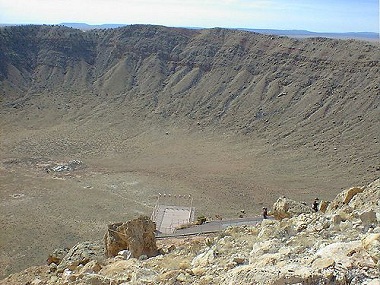
In 1902, a mining engineer, Daniel Barringer, thought that the crater was formed by an enormous iron meteorite, which would have been buried below the surface. He formed the Standard Mining Company, which involved acquiring the land within a two-mile radius of the crater. Some of the mining areas within the crater can be viewed from the rim of the crater. It took over 25 years to try to uncover the meteorite, and this was accompanied by extensive scientific research.

Some of the research enabled the trajectory of the meteorite to be calculated from studying the positions of the sandstone and limestone beds around the crater. It is now accepted that the meteorite, travelling at such a velocity would have been totally disintegrated as a result of the combination of the processes of vaporisation, the melting of the meteorite, and in the fragmentation upon impact with the ground.
The Barringer Crater was one of the official centres by NASA for training Apollo astronauts. The terrain is similar to that found on the Moon and it proved to be a valuable training resource.
Entrance to the now controlled by Meteor Crater Enterprises Inc, which has a long-term lease with the Barringer family. There is a visitors centre, with exhibits of the science of meteorites and the history of the site, and the use of the crater in the NASA Apollo Space Programme
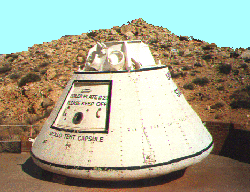
Further information about Meteor Crater and other impact craters around the world:
Meteor Crater Homepage
Barringer Crater
Images of the Crater (NASA)
Earth Impact Database






